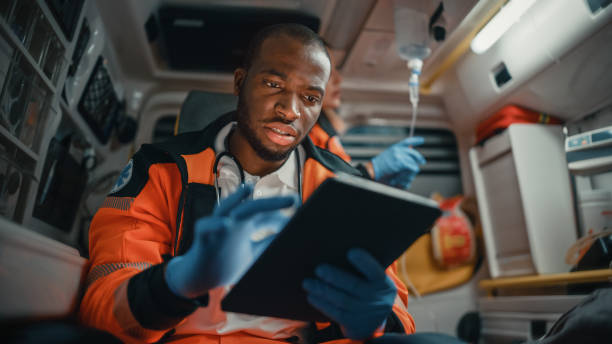EMS telemedicine enables rural populations access to emergency medical care through real-time video connections between paramedics and hospital physicians. New advances in EMS telemedicine provide faster diagnosis and more informed care decisions in critical health events like strokes and heart attacks. It also facilitates treatment in place for non-life-threatening 911 calls.
Key benefits include quicker access to medical specialists, reduced ambulance transports and ER visits, and better health outcomes. EMS telemedicine is transforming emergency care delivery across rural America by enabling rapid consultations between first responders and doctors.
Benefits of Telemedicine for Rural Populations
More than 46 million people live in rural America. Rural Americans have higher rates of severe illness and death from heart disease, cancer, unintentional injury, chronic lower respiratory disease, and stroke than their urban counterparts. In addition, people living in rural areas may be limited from accessing the quality medical care services they need.
The benefit of EMS telemedicine in rural areas is that it provides access to emergency medical care for those with barriers to care, such as:
- Geographic distance from specialists and treatment centers
- Minimal public transportation
- Healthcare provider shortages
EMS is critical when a severe injury, illness, or significant trauma occurs, but providing pre-hospital services in rural areas is challenging. Moreover, acute trauma care requires rapid assessment of severity, timely stabilization of vital signs, and prompt hospital treatment. In particular, timely identification of stroke and heart attack is essential.
Properly evaluating high-risk surgical candidates with EMS and telemedicine helps facilitate surgical decision-making and care management strategies. In cases such as stroke or cardiac arrest, professionals make quick decisions in short time frames under intense conditions and with limited information. EMS telemedicine programs can connect paramedics in real-time to trauma specialists to help stabilize a patient who may have up to an hour’s drive to a hospital.
South Dakota and EMS Telemedicine in Motion
Access to health care is a challenge in much of rural South Dakota. Along with Avel eCare, the South Dakota Department of Health created an EMS telemedicine program called Telemedicine in Motion for EMS. The initiative is the first in the nation to offer advanced care to patients and support emergency medical service professionals.
Telemedicine EMS responders are connected via a telehealth-enabled iPad to Avel eCare’s emergency medicine experts to interact with physicians and nurses. As a result, EMS telemedicine crews can maintain connections in the state’s most remote areas. With cellular boosters responders can provide real-time updates to entire medical teams. When the hospital understands what is happening, medical teams are better prepared for arrival.
On-Scene Treatment in Tennessee
Baptist Ambulance in Tennessee launched a new Centers for Medicare & Medicaid Services (CMS) EMS telemedicine program called Triage, Navigate, Treat, Transport (ET3) Model. It provides telehealth visits to TennCare patients who call 911 with non-threatening injuries or illnesses. The program cuts down on emergency room visits and allows first responders to treat non-urgent patients on-scene.
The new program is estimated to save more than $8 million annually in TennCare expenses and is expected to improve patient outcomes. Under the ET3 model, CMS pays ambulance suppliers and providers to perform one of the three following services:
- Transport an individual to a hospital emergency department (ED) or other destination covered under regulations.
- Transport to an alternative destination (such as a primary care doctor’s office or an urgent care clinic).
- Provide treatment in place with a qualified health care practitioner, either on the scene or connected using telehealth.
Additionally, the program aims to provide increased flexibility to ambulance care teams to address emergency health care needs of Medicare Fee-for-Service (FFS) beneficiaries following a 911 call.
EMS Telemedicine & Stroke Prevention
UVA Health in central Virginia launched an EMS telemedicine program from the federal Health Resources & Services Administration. With the iTREAT (Improving Treatment with Rapid Evaluation of Acute Stroke via Mobile Telemedicine) system, paramedics who suspect patients are having a stroke are now connected through a secure live video link to UVA’s trained stroke neurologists and emergency medicine physicians. In a 2016 single-center study, iTREAT was feasible for mobile rural telestroke assessment using low-cost components and commercial wireless connectivity.
A 2019 study of NewYork-Presbyterian Hospital’s mobile telestroke program reported that ambulances equipped with EMS telemedicine technology for strokes can shave 30 minutes off the average treatment time, potentially saving lives. The mobile telestroke program outfits ambulances with telehealth technology which connects paramedics with neurologists at the nearest hospital and supports quicker stroke diagnoses. Additionally, the patients in this environment received dispatch-to-thrombolysis care in about 61 minutes. The average was 91 minutes for those transported by a conventional ambulance.
Expanding EMS Telemedicine Training for Detecting Stroke
With the federal grant, UVA Health will also be conducting training on the following latest EMS telemedicine techniques.
- Pre-hospital emergency care: Focuses on community paramedicine to reduce 911 calls for non-urgent medical needs, help patients access primary care services, and assist patients with post-hospital follow-up care.
- Stroke education: EMS and medical professionals will receive continuing online education on stroke and other cardiovascular diseases.
- EMS telemedicine training: EMS and medical professionals will receive training on integrating telehealth technologies into care plans.
EMS Telemedicine Key Points
Transportation is a barrier to receiving quality healthcare in rural and remote areas. EMS often becomes the transportation mode for rural populations. Telemedicine technology connects patients to healthcare practitioners remotely. EMS responders can triage patients in non-emergency conditions to decrease ambulance transports. Telemedicine and telehealth appointments can help patients receive a higher level of care when access or distance prevents in-person assessments.
Programs like the Emergency Triage, Treat, and Transport (ET3) Model allow EMS agencies to partner with qualified healthcare providers to deliver treatment on-scene, via telehealth, or by offering alternative destination sites, such as primary care offices or urgent-care clinics.
Are you ready to learn more about remote patient monitoring? Tenovi offers a convenient cellular hub and bluetooth device options for rural patient care. Schedule your free demo, with Tenovi, and get ready to meet a better RPM experience.






